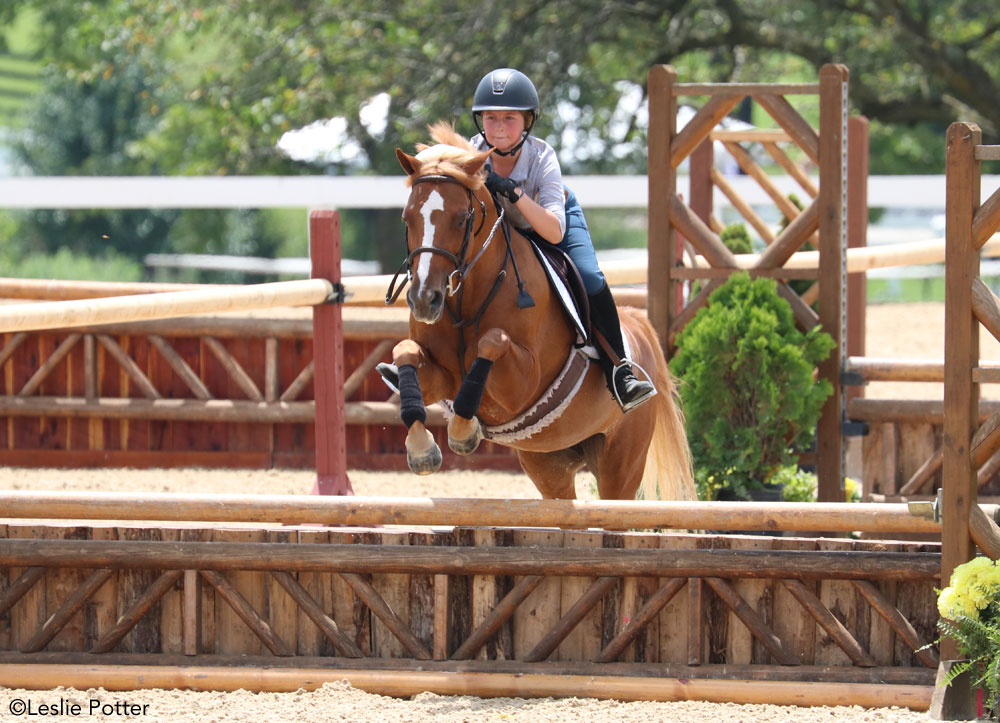
Finding a distance is when you can see a very specific point on your path to the fence where your horse will take off to jump. The perfect distance is neither too close nor too far away from the fence.
Seeing a Distance
Learning to find a distance can be tough. Sometimes, no matter what you do, it can seem like your horse always squeezes in a teeny-tiny stride right before the fence (chipping) or launches himself from way too far away from the jump (a long spot).
So how can you work on seeing a distance so your horse gets the perfect spot to every fence, making his jumping rounds look effortless?
Often, problems seeing a distance are caused by you and your horse not having a steady rhythm. An average horse takes a 12-foot stride; if your horse slows down in the corner, that stride can compress to 10 or 11 feet—just enough to make finding the perfect distance impossible.
Keep Your Pony on Pace
It’s easy to just ask your pony to canter and aim for the first fence, not paying attention to whether he’s keeping a steady pace. If he happens to slow down (which most horses will), you’ll miss the distance to the first fence in a line, so you have to kick-kick-kick to get him to the second fence in the proper number of strides (and even then, sometimes the horse won’t get it!).
So how do you make sure you pay attention to your pony’s pace so he gets the right distance to the fence? You’ll need to work on rhythm and pace on the flat, getting a quality “jumping canter” before you ever try to find the perfect jumping distance.
A jumping canter is one that is bouncy, with your pony up in front of your leg and moving forward. His hind end—or “motor”—is engaged, and you feel like you could jump a big fence if it were put in front of you.
Here are some exercises to help find that perfect canter:
Lengthen and shorten your canter stride.
Work on lengthening your canter stride on the long side of the arena, asking your horse to move forward and lengthen his stride, not just go faster. When you get into the corner, sit deeper and ask him to shorten his stride, but don’t let him break to a trot! He will have to work hard to sit back on his hocks and compress his stride.
Circle in the corners.
Corners are where horses tend to slooooowww down and lose the quality of their canter. Try circling in each corner of your arena, making sure that your horse is still moving forward in the same pace he was on the long side of the arena.
Canter poles on the ground.
The best way to learn to see a distance without putting too much wear and tear on your horse is to canter poles on the ground as if they were jumps. On the long side of the arena, put a pole on the ground, measure or walk off 69 feet, and place another pole (if these were real jumps, the distance between the poles would be 72 feet to allow your horse to take off and land). Because an average stride for a horse is 12 feet, your horse should be able to fit five easy strides between the poles. For ponies, distances should be shorter.
Right Distance: How to Ride the Canter Poles
Don’t let the poles on the ground intimidate you. Remember, they’re just poles! Try to get a bouncy, collected canter as you head toward the poles. Your horse should feel like he is sitting on his hocks; his hocks act like a spring when he jumps, allowing him to go up and over the fence in a nice jump. Don’t drive him out of the corner, but pay attention that you don’t let him suck back as he makes the turn toward the poles.
Choose a point beyond your poles and focus on it. Without trying to adjust your horse’s stride at all, simply canter the line.
If you got six strides in the line, you will know you need to ask your horse for a little more pace as he enters the corner—don’t try to get more pace as you come out of the corner, which will slingshot him around the turn and make it hard for him to get the correct distance to the pole on the ground.
If you got four strides, your horse’s canter may not be bouncy enough. Work on collecting him and not letting him run at the poles.
If you got five strides, perfect! You want them to be even and consistent.
Right Distance to a Jump: Adjustability
Once you’ve mastered the five-stride line and you know what kind of bouncy, quality canter you need to get it, see if you can hold your horse and get six strides in between the poles. Remember: It’s not just about going slow—it’s about keeping him engaged so that when the poles are actual jumps, he will have a nice canter.
When you and your horse can handle these exercises with ease, you’ll have the control and rhythm you need to hit the perfect stride every time!
This article about finding the right distance to a jump originally appeared in the September/October 2017 issue of Young Rider magazine. Click here to subscribe!





